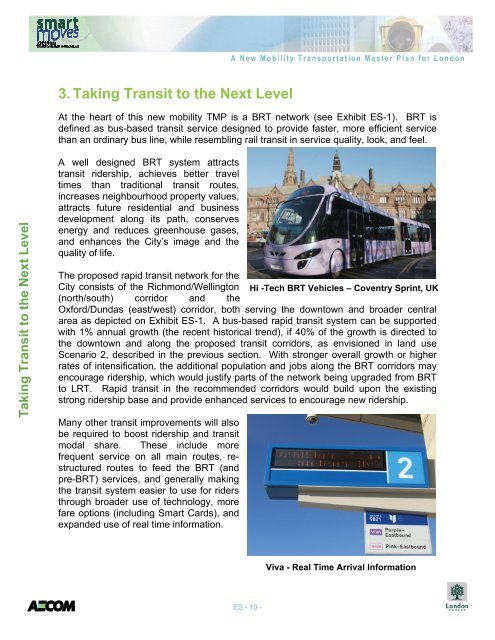A New Mobility Transportation Master Plan for London
A New Mobility Transportation Master Plan for London
A New Mobility Transportation Master Plan for London
You also want an ePaper? Increase the reach of your titles
YUMPU automatically turns print PDFs into web optimized ePapers that Google loves.
Taking Transit to the Next Level<br />
3. Taking Transit to the Next Level<br />
A <strong>New</strong> <strong>Mobility</strong> <strong>Transportation</strong> <strong>Master</strong> <strong>Plan</strong> <strong>for</strong> <strong>London</strong><br />
At the heart of this new mobility TMP is a BRT network (see Exhibit ES-1). BRT is<br />
defined as bus-based transit service designed to provide faster, more efficient service<br />
than an ordinary bus line, while resembling rail transit in service quality, look, and feel.<br />
A well designed BRT system attracts<br />
transit ridership, achieves better travel<br />
times than traditional transit routes,<br />
increases neighbourhood property values,<br />
attracts future residential and business<br />
development along its path, conserves<br />
energy and reduces greenhouse gases,<br />
and enhances the City’s image and the<br />
quality of life.<br />
The proposed rapid transit network <strong>for</strong> the<br />
City consists of the Richmond/Wellington Hi -Tech BRT Vehicles – Coventry Sprint, UK<br />
(north/south) corridor and the<br />
Ox<strong>for</strong>d/Dundas (east/west) corridor, both serving the downtown and broader central<br />
area as depicted on Exhibit ES-1. A bus-based rapid transit system can be supported<br />
with 1% annual growth (the recent historical trend), if 40% of the growth is directed to<br />
the downtown and along the proposed transit corridors, as envisioned in land use<br />
Scenario 2, described in the previous section. With stronger overall growth or higher<br />
rates of intensification, the additional population and jobs along the BRT corridors may<br />
encourage ridership, which would justify parts of the network being upgraded from BRT<br />
to LRT. Rapid transit in the recommended corridors would build upon the existing<br />
strong ridership base and provide enhanced services to encourage new ridership.<br />
Many other transit improvements will also<br />
be required to boost ridership and transit<br />
modal share. These include more<br />
frequent service on all main routes, restructured<br />
routes to feed the BRT (and<br />
pre-BRT) services, and generally making<br />
the transit system easier to use <strong>for</strong> riders<br />
through broader use of technology, more<br />
fare options (including Smart Cards), and<br />
expanded use of real time in<strong>for</strong>mation.<br />
ES - 10 -<br />
Viva - Real Time Arrival In<strong>for</strong>mation


